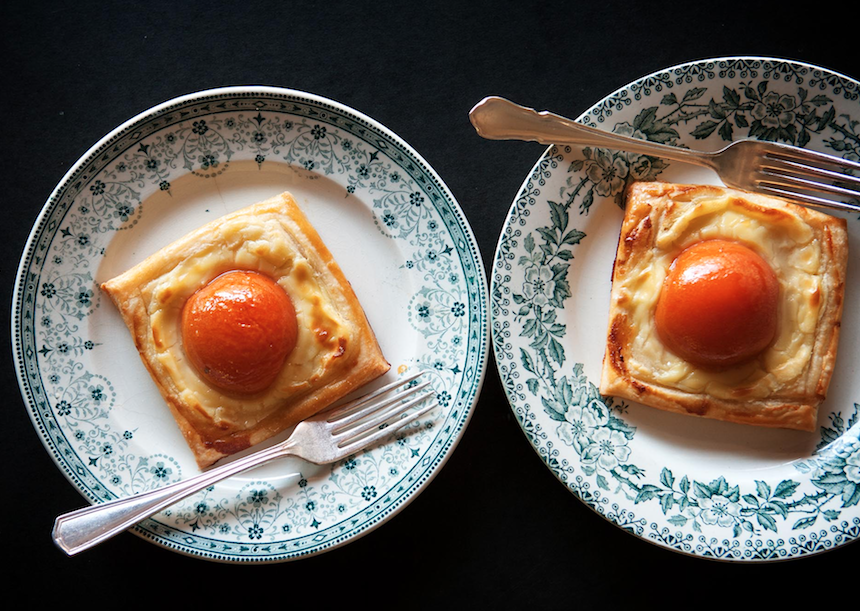FRESH APRICOT BREAKFAST PASTRIES

MAKES 12
I am weak as a kitten around ripe apricots; I’ll eat them until my stomach hurts. I had my first ever as a 24-year-old traveling in Italy and forevermore looked for that tart, sweet, glorious sunny flavor. This elegant pastry is usually found in the most swish of Parisian patisseries, yet it’s dead simple to make once you’ve mastered quick puff and pastry cream, two skills that are always good to have in your arsenal. Cut the fruit at the very last minute and toss with the lemon juice right away so it will not oxidize and discolor. Pay close attention to the quality of the fruit and make sure they are the same size with no bruises—and these pastries will look very fancy indeed. Apricot is the classic flavor, but apricots can be difficult to find on the East Coast, so I often substitute white peaches, which hold a similar, though more floral, allure. You could also substitute blueberries, raspberries, halved pitted cherries or plums, or any combination of summer fruit.
INGREDIENTS
- 1 recipe (20 ounces, 500 g) Quick Puff Pastry (recipe below) or store-bought
- 6 ripe apricots, halved and pitted; or 3 small white peaches, pitted and quartered
- 1 tablespoon granulated sugar
- 1 tablespoon freshly squeezed\ lemon juice
- Egg wash (1 egg beaten with 1 tablespoon cool water and 1/4 teaspoon kosher salt)
- Pastry Cream (recipe below) cold
- 3 tablespoons apricot jam, heated and strained
- Powdered sugar, for dusting
DIRECTIONS
Line a baking sheet with parchment. Lightly dust the counter, the puff pastry, and the rolling pin with flour. Roll out the dough to a 16- by 12-inch rectangle and cut into 12 (4-inch) squares.
Stir the fruit, sugar, and lemon juice together. Place the pastry squares on the parchment-lined baking sheet spaced evenly apart. Using a paring knife, make a shallow knife slash around each square, . inch from the edges. Dock the center of each square by making a shallow X, again, not slicing all the way through.
Paint the egg wash on the edges of each square. Pipe or spoon about 2 tablespoons pastry cream in the center. Chill the pastries for 30 minutes before baking.
Heat the oven to 400˚F.
Top the pastry cream with the apricot halves, rounded side up. Slide the pastries into the oven and bake for 20 to 25 minutes. The pastry will turn deeply golden brown and the fruit and pastry cream will get very gently freckled here and there. Remove from the oven and brush the surface of the fruit with the warm jam.
Cool a little before serving, then dust generously with powdered sugar and dig in. If you choose to stand over the pastries as they cool to smell the warm apricots mingling with the vanilla-scented pastry cream, who am I to stop you?
***
QUICK PUFF PASTRY
Makes 1 block (20 ounces, 500 g)
Puff pastry is laminated dough, a reference to the layers folded into a buttery mass. Traditional puff pastry uses nothing but flour and butter, the butter beaten flat and then folded and rolled and folded and rolled and reworked= four times, each called a “turn.” Here, in the quick version of traditional puff, the dough is made in the mixer, the folds and turns happen all at once, and it’s much less work. (If this seems difficult, it’s worth making real puff pastry once to see what a joy this version is.) I like to make a double recipe, and then cut it into two portions, freezing one for later.
I make puff with regular American-style butter because that’s what is usually in my freezer, but you can use lovely fancy butter if you wish. This pastry is all about buttery flake and flavor. In the recipes on pages 157 to 163, you’ll be most successful rolling and portioning if you remain obsessively diligent about keeping the dough very very cold, never never never smeary, and the edges of the dough block and the rolled dough very squared and even. Use the bench scraper to make those crisp edges. Be obsessive.
INGREDIENTS
- 2 cups (240 g) all-purpose flour
- 3/4 teaspoon kosher salt
- 16 tablespoons (226 g) unsalted butter, cut into 1/2-inch dice and refrigerated at least 1 hour
- 1/2 cup (120 ml) cold water
- 1/4 teaspoon freshly squeezed lemon juice
DIRECTIONS
Place the flour and salt in the bowl of a stand mixer with the paddle attachment. With the mixer on low, add the butter a few cubes at a time until the dough is a collection of little bits about the size of jelly beans. It should seem dry-ish and pebbly. With the mixer still running, add the water and lemon juice in a steady stream. Mix for 30 seconds. Turn out the crumbly dough onto the work surface and, using your hands and a bench scraper, press and shape the dough into a long firm rectangle 10 by 5 inches.
Use the bench scraper to fold the dough in thirds, like a business letter, so it is about 5 by 3 inches. Turn the dough 90 degrees and reroll the dough into a rectangle 10 by 5 inches. Repeat the folding and rotating three times for a total of four turns. If the dough becomes too sticky to work with, place it on a baking sheet and chill until firm, then resume your rolling and turning.
Form an X with two long pieces of overlapping plastic wrap and lightly flour the surface. Place the tidy rectangle in the center of the plastic wrap. Wrap the dough in the plastic and, at the same time, use a bench scraper to form the squared sides of the 5- by 3-inch block. Once wrapped, use a rolling pin to gently press across the surface of the block, smoothing the top. Flip it over and do the same on the other side. Square it up again. Now let it rest: Refrigerate the dough for at least 4 hours or preferably overnight. Quick Puff Pastry will keep refrigerated for 3 days or in a ziptop bag in the freezer for 3 months. Defrost in the refrigerator overnight.
***
PASTRY CREAM
Makes 1-1/2 cups
Pastry cream is rich and velvety. It’s the eggy, creamy base for fruit tarts and tartlettes and makes insanely delicious treats (such as Fresh Apricot Breakfast Pastry, page 163). Below is a classic vanilla cream, but . teaspoon almond extract may be swapped in for the vanilla extract. Or stir in 1 teaspoon rum, cognac, bourbon, kirsh, or orange liqueur to take the flavor in an adult direction.
INGREDIENTS
1-1/2 cups (360 ml) whole milk
3 tablespoons cornstarch
1 tablespoon all-purpose flour
3 large egg yolks, lightly beaten
1/4 cup (50 g) granulated sugar
1/8 teaspoon kosher salt
2 tablespoons (28 g) unsalted butter, cubed
1/2 teaspoon vanilla extract
DIRECTIONS
Set a strainer over a bowl placed inside an ice bath.
In a small mixing bowl, whisk . cup of the milk with the cornstarch, flour, and egg yolks and set aside.
Combine the remaining 1 cup milk with the sugar and salt in a medium saucepan over medium-high heat. Let the mixture warm, stirring all the time as the sugar dissolves, about 4 minutes, until small bubbles appear at the edges.
Slowly whisk 1/4 cup of the warm milk mixture into the egg yolk mixture. This process is called tempering and will keep the yolks from scrambling.
Pour the egg-milk mixture back into the warm milk in the pan, whisking the whole time. The next step should take about 5 minutes. Return the pan to medium-high heat, bring the mixture to a boil, and cook, constantly whisking, until the mixture thickens into a smooth sauce. This transformation will happen very suddenly, so stay vigilant; the pastry cream will be thick like custard or warm pudding.
Remove the pan from the heat and use the whisk or a sturdy spoon to push the custard through the strainer into the bowl set over the ice bath, removing any lumps. Stir in the butter cubes and vanilla extract and continue to stir until the pastry cream has cooled.
Cover with plastic wrap touching the surface of the custard to keep a skin from forming. Refrigerate for 2 hours, or until entirely cool. The custard will keep 3 days, but it’s best when fresh. Custard does not freeze well.
WHEN PIES FLY guides the rolling pin novice and the experienced dough wrangler to dozens of shapes and styles of crusty, flaky, delicious treats. Barrow's well-tested, foolproof crust recipes means pie-making is fun, not scary, and her step-by-step techniques makes turning out a free-form pie practically foolproof.
WHEN PIES FLY includes many types of pastries (both homemade and store-bought), ready for the lunchbox, the dinner table, road trips, and picnics. These handy crusty offerings go from freezer to oven, and will win over everyone at the table. No one will be able to resist Sesame Chicken Hand Pies, Savory Nectarine Marscapone Tarts, Pork Pastor Empanadas, Spiced Apple Strudels, and much more. The perfect mix of nostalgic favorites and new pastry creations, WHEN PIES FLY is a wonderful dive into the world of pies in all of their forms.
By clicking ‘Sign Up,’ I acknowledge that I have read and agree to Hachette Book Group’s Privacy Policy and Terms of Use
